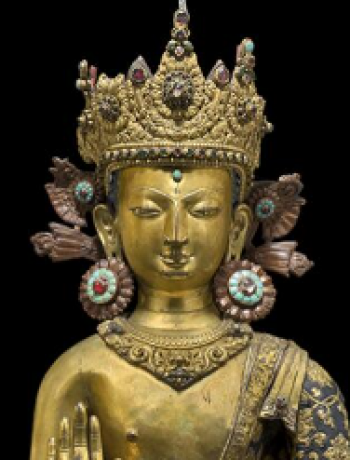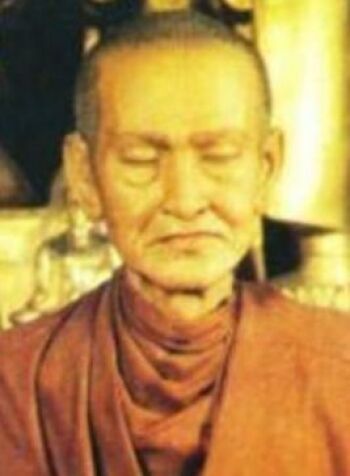Religion: Religious Leaders Pre-1900
Dipankara (Unknown)

Religion: Buddhism
Title: Buddha
Dipankara is one of the Buddhas of the past in Buddhist cosmology. In Buddhist belief, before the historical Buddha (Siddhartha Gautama) attained enlightenment, many other Buddhas had existed in previous ages. Dipankara is one of the most famous and widely venerated of these past Buddhas.
Dipankara is often remembered as the Buddha who predicted that Siddhartha Gautama would become a Buddha in the future. According to various texts and traditions, during the time of Dipankara Buddha, Siddhartha was born as Sumedha, an ascetic. Upon seeing Dipankara, Sumedha laid down in the mud so that Dīpankara could walk over him, preventing the Buddha from getting muddy. In appreciation of this act of devotion and humility, Dipankara made the prediction about Sumedha's future enlightenment.
Dipankara is often depicted in Buddhist art, and his images can be found in many temples and monasteries throughout the Buddhist world. He is usually shown in typical Buddha postures, sometimes with distinguishing symbols or attributes.
In certain Buddhist traditions, particularly in Theravada countries such as Sri Lanka, Myanmar, and Thailand, Dipankara holds a special place of reverence. He is invoked for blessings, and stories of his life and teachings are recounted as part of the larger narrative of the Buddhas.
Like other Buddhas, Dipankara is believed to have taught the Dharma (Buddhist teachings) to the beings of his time, guiding many to enlightenment. He is one of the ancient Buddhas who is remembered and venerated for his teachings and his role in predicting the enlightenment of the historical Buddha, Siddhartha Gautama.
Naropa (956-1041)
Religion and Branch: Buddhism (Tibetan)
Title: Mahasiddha, Educator
Naropa is a central figure in the history of Tibetan Buddhism, particularly within the Vajrayana (Tantric) tradition. His life and teachings have had a profound influence on various lineages and practices that are prevalent today.
Born in Bengal, India, Naropa hailed from a royal family. He received a vast education in both secular and religious subjects, which made him one of the most learned scholars of his time.
Naropa served as a renowned scholar at the prestigious Nalanda University, one of ancient India's major centers of learning. Here, he was deeply engaged in academic and philosophical discourses.
Despite his knowledge and stature at Nalanda, Naropa felt an inner dissatisfaction. Following a series of visions and dreams, he left his esteemed position in search of greater spiritual realization. This search led him to his destined guru, Tilopa, from whom he received the teachings of Mahamudra and other Tantric practices.
One of Naropa's most significant contributions to Vajrayana Buddhism is the Six Yogas of Naropa. These are advanced tantric practices aimed at achieving enlightenment swiftly. They include tummo (inner heat), Illusory body, dream yoga, clear light, bardo (intermediate state), and phowa (transference of consciousness at the time of death).
Naropa's journey with Tilopa was not easy. He underwent 12 major and 12 minor hardships, tests of his perseverance, determination, and dedication. These trials purified his obscurations and deepened his realization.
After achieving profound realizations, Naropa became a master in his own right. He was instrumental in transmitting Vajrayana teachings to the next generation of practitioners. His most famous student, Marpa the Translator, traveled from Tibet to India to study under Naropa. Marpa then carried these teachings back to Tibet, where they became foundational to the Kagyu lineage of Tibetan Buddhism.
Naropa is venerated as a Mahasiddha (a great accomplished one) in both the Buddhist and Hindu tantric traditions. The teachings and practices he propagated continue to inspire and guide practitioners in the Vajrayana path, particularly within the Kagyu lineage of Tibetan Buddhism. His life exemplifies the transformative power of the guru-disciple relationship and the depth of realization attainable through authentic tantric practices.
Luang Pu Thuat (1582-1628)
Religion and Branch: Buddhism (Theravada)
Title: Monk
Luang Pu Thuat is a revered and legendary figure in Thai Buddhism, particularly within the Theravāda tradition. He was born in the Kingdom of Siam (now Thailand). Over the years, many legends and miracles have been attributed to him, which has made it difficult to separate historical facts from myths.
Among the most famous legends associated with Thuat is the miracle of turning seawater into freshwater. This tale recounts that during a voyage, when the boat he was on ran out of drinking water, he dipped his foot into the sea, and the seawater turned into freshwater, saving all on board.
Thuat was known for his deep knowledge of the Dhamma (Buddha's teachings) and his skills in meditation. He traveled widely, teaching the Dhamma and helping to establish various monastic communities.
Thuat is one of the most revered monk figures in Thailand. Amulets bearing his image are believed to bring protection and good fortune to the wearer. These amulets are among the most popular and sought-after in Thailand.
Many temples across Thailand have statues or shrines dedicated to Luang Pu Thuat, and he is particularly venerated in Southern Thailand. The temple Wat Chang Hai in Pattani province is one of the most famous associated with him, as it's believed to be where he stayed and practiced his monastic duties.
Thuat is a significant figure in Thai Buddhism, representing the ideal of a monk who possesses both deep wisdom and the power to perform miracles. His legacy continues to be felt today through the widespread veneration of his image and the stories that surround his life.
Somdet To (1788-1872)

Religion and Branch: Buddhism, Theravada
Title: Somdet
Somdet To, known formally as Somdet Phra Buddhacarya (To Brahmaramsi), is one of the most renowned and venerated monk figures in the history of Thai Buddhism. Born in Ayutthaya province, Thailand, he was of Mon descent and orphaned at a young age.
To became a novice monk at an early age and received higher ordination when he turned 21. He studied under several esteemed monks and quickly gained a reputation for his deep understanding of the Pali scriptures and Buddhist teachings.
To was known for his expertise in both the theoretical (scholarly) and practical (meditative) aspects of Buddhism. He was highly respected for his knowledge of the Dhamma and his meditation practices.
To is perhaps most famous for the creation of a particular type of amulet known as Phra Somdet. These amulets, made from a mixture of sacred substances, are believed to provide protection and bring blessings to those who wear them. The amulets from his era are among the most prized and sought-after by collectors and devotees.
To's teachings and works had a profound influence on Thai Buddhism. Many monks regarded him as the Sangharaja or "Leader of the Sangha," even though he never officially held this title. His legacy endures, with many of today's monks tracing their lineage back to him.
To was associated with Wat Rakang Kositaram in Bangkok, but he also had connections with other temples. He played a vital role in the construction and restoration of several temples and Buddhist monuments.
To's importance cannot be overstated. His contributions to the Dhamma, his role in the development and popularization of Thai amulets, and his lasting influence on the Thai monastic community have solidified his place as one of the most significant figures in Thai religious history. He continues to be venerated widely in Thailand, and his teachings are still studied.
Ahmad al-Fathani (1856-1908)
Religion and Branch: Islam (Sunni)
Title: Scholar, Educator, Writer
Ahmad al-Fathani, also known as Tok Kenali, is a prominent figure in the Islamic educational landscape of the Pattani region in Southern Thailand. He is particularly notable for his contributions to Islamic scholarship, education, and the propagation of the faith in the Malay Peninsula.
Al-Fathani was born in the Pattani province, which is located in the southern part of Thailand. The region has a significant Malay-Muslim population, and historically, Pattani was an independent sultanate with strong Islamic influences before becoming part of Thailand.
Al-Fathani was a dedicated scholar who pursued Islamic studies extensively. He studied under various renowned scholars in Pattani before traveling to Mecca for further education.
After returning from Mecca, al-Fathani played an instrumental role in the establishment and promotion of traditional Islamic schools, known as pondok, in the Pattani region. His approach to education emphasized the classical Islamic sciences and aimed to provide a comprehensive understanding of Islam based on its primary sources.
Al-Fathani is well-regarded for his Islamic treatises and books. His writings have been influential in guiding the understanding and practice of Islam in the region.
Al-Fathani's impact on the Islamic educational framework in Southern Thailand has been profound. Many of the established Islamic schools in Pattani and neighboring provinces trace their educational lineage back to him. He is remembered as a luminary who contributed significantly to the religious and intellectual life of the Malay-Muslim community in the region.
The Pattani region, where al-Fathani lived and taught, has seen ongoing tensions and conflicts, with ethnic and religious dimensions, between the Thai government and Malay-Muslim separatists. His legacy is often invoked in the context of these challenges, symbolizing the deep-rooted Islamic heritage and identity of the region.
Al-Fathani is a revered figure in the history of Islam in Southern Thailand. His contributions to education and Islamic thought have left a lasting legacy in the region, shaping the religious landscape for subsequent generations.
Copyright © 1993—2024 World Trade Press. All rights reserved.

 Thailand
Thailand